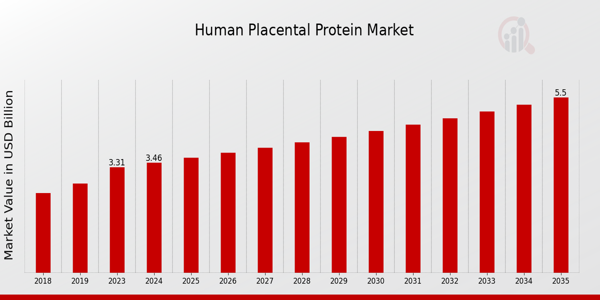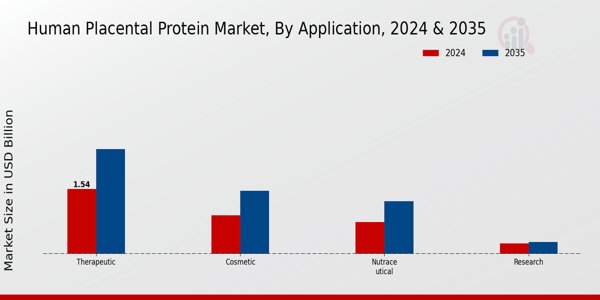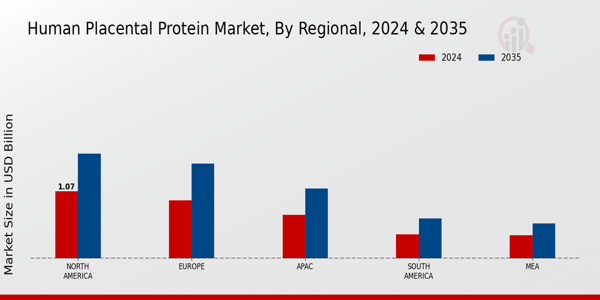Human Placental Protein Market Overview
As per MRFR analysis, the Human Placental Protein Market Size was estimated at 3.31 (USD Billion) in 2023. The Human Placental Protein Market Industry is expected to grow from 3.46(USD Billion) in 2024 to 5.5 (USD Billion) by 2035. The Human Placental Protein Market CAGR (growth rate) is expected to be around 4.31% during the forecast period (2025 - 2035).
Key Human Placental Protein Market Trends Highlighted
The Global Human Placental Protein Market is driven by several key factors. The growing awareness of the benefits of human placental protein in medical and cosmetic applications has significantly influenced market dynamics. Increased research and development in this field are fostering innovations that enhance product efficiency and effectiveness. The rising prevalence of chronic diseases and the demand for advanced therapeutic treatments further propel market growth. Additionally, changing consumer preferences toward natural and organic products in skincare and health supplements support market expansion. Opportunities in the Global Human Placental Protein Market are plentiful.There is potential for expanding product lines that cater to various demographics, such as age-specific formulations.
The integration of human placental protein in cellular therapies and regenerative medicine offers avenues for research and product development. Moreover, tapping into emerging markets and regions with rising disposable incomes can lead to increased demand for these products. Collaborations with research institutions can also pave the way for new product innovations and applications. Recent trends indicate a growing focus on sustainability and ethical sourcing of human placental protein.
Consumers are increasingly concerned about the origins of their products, prompting companies to adopt transparent supply chains.Advances in biotechnology and extraction methods are making it easier and more efficient to obtain high-quality human placental protein, thus enhancing product appeal. The trend toward holistic wellness is also shaping product development as consumers seek comprehensive solutions that address both health and cosmetic needs. These evolving preferences signal a shift towards more integrated and multifaceted applications of human placental protein in various industries.

Source: Primary Research, Secondary Research, MRFR Database and Analyst Review
Human Placental Protein Market Drivers
Increasing Demand for Biopharmaceuticals
Due to the rapid innovations in biotechnology and the increased focus on developing novel therapeutics, there is a surge in the demand for biopharmaceuticals, which, in turn, fosters growth in the Global Human Placental Protein Market. Human placental proteins have been integrated into many therapies due to the medical marvels they can achieve within immune disorders, cancer and even regenerative medicine.
To adapt to this evolving market, there is a great focus on targeted research and development, as well as having effective therapies as a major goal. Creative treatments are being sought to tackle chronic diseases that have surged over the years due to an aging population which in turn is benefitting the Global Human Placental Protein Market.
Healthcare staff are becoming more focused on the individual needs of their patients, which has paved the way for personalized medicine. This newly established practice will drastically improve the Global Human Placental Protein Market as more biopharmaceuticals are demanded.
Rising Awareness and Acceptance of Regenerative Medicine
The Global Human Placental Protein Market industry is benefitting from the increasing awareness and acceptance of regenerative medicine. As advancements in stem cell research and tissue engineering continue to grow, medical professionals and patients alike are embracing innovative treatments that utilize human placental proteins. These proteins play a critical role in cellular regeneration and repair, making them valuable in addressing a range of medical conditions.The growing focus on regenerative medicine opens doors for the development and application of placental protein-based therapies, further stimulating market growth.
Technological Advancements in Protein Extraction and Purification
Innovations in protein extraction and purification technologies are significantly impacting the Global Human Placental Protein Market industry. Enhanced methods for isolating and refining placental proteins not only increase yield but also improve the functionality of these proteins in medical applications. This progress enables researchers and manufacturers to develop more effective therapies and products, catering to the rising demand within the market.The continuous evolution of processing technologies is, therefore, a key driver of growth in this sector.
Human Placental Protein Market Segment Insights
Human Placental Protein Market Application Insights
The Global Human Placental Protein Market revenue is poised for substantial growth across various application areas, with a projected valuation of 3.46 USD Billion in 2024, reflecting the rising interest and utilization of human placental proteins in several sectors. By 2035, the market is expected to reach 5.5 USD Billion, driven by increasing research and advancing technologies. Among the applications, the Therapeutic segment holds the majority share, valued at 1.54 USD Billion in 2024 and forecasted to reach 2.48 USD Billion by 2035.
This segment is significant due to the therapeutic properties associated with human placental proteins, which are increasingly being recognized for their potential to aid in various health conditions and treatments. The Cosmetic application is also noteworthy, with an initial value of 0.92 USD Billion in 2024 and an increase to 1.49 USD Billion in 2035. The growth in this segment can be attributed to the rising demand for advanced cosmetic formulations harnessing the benefits of human placental proteins, which are known for their regenerative and rejuvenating qualities on the skin.
Following closely is the Nutraceutical segment, which generated a revenue of 0.75 USD Billion in 2024 and is projected to grow to 1.25 USD Billion by 2035; this growth reflects the increasing focus on nutritional supplements that leverage the health benefits of placental proteins, appealing to a health-conscious consumer base. Lastly, the Research segment, although smaller, with a value of 0.25 USD Billion in 2024, is expected to see modest growth, reaching 0.28 USD Billion by 2035.
The importance of this segment lies in its contribution to scientific studies and clinical trials exploring the myriad applications of human placental proteins in medicine. The Global Human Placental Protein Market statistics reveal a dynamic industry landscape where therapeutic uses dominate, while cosmetics and nutraceuticals present significant opportunities for growth, addressing consumer needs for health and beauty. The market growth is further supported by evolving consumer preferences towards natural product ingredients and a growing awareness of the health benefits attributed to human placental proteins across these diverse applications.

Source: Primary Research, Secondary Research, MRFR Database and Analyst Review
Human Placental Protein Market End Use Insights
The Global Human Placental Protein Market has shown significant growth within its End Use segment, which encompasses various vital categories such as Pharmaceuticals, Biotechnology, Healthcare, and Cosmetics. With the market expected to be valued at 3.46 billion USD by 2024, this area is crucial for the overall market growth. Pharmaceuticals dominate this segment due to the rising demand for innovative therapies and treatments, particularly in areas like regenerative medicine. Additionally, the biotechnology sector is gaining traction as it utilizes human placental protein for developing advanced biopharmaceuticals, steering the market forward.
The healthcare industry also plays a vital role, leveraging human placental proteins for diagnostic applications and therapeutic interventions. Furthermore, cosmetics manufacturers have increasingly recognized the benefits of these proteins, leading to their incorporation in skincare and beauty products. The interplay of these segments creates both opportunities and challenges within the Global Human Placental Protein Market, influenced by regulatory factors and the need for continuous research and development to satisfy rising consumer demands.Overall, the market data indicates a compelling landscape where the End Use segmentation is pivotal for driving innovation and growth across various industries.
Human Placental Protein Market Source Insights
The Global Human Placental Protein Market, valued at 3.46 USD Billion in 2024, showcases a diverse segmentation, particularly within the Source category. This category includes Human Placenta, Synthetic and Natural Extracts, each playing a crucial role in the market's dynamics. The Human Placenta is recognized for its rich protein content and bioactive compounds, preparing it as a robust choice in various applications ranging from cosmetics to pharmaceuticals. Synthetic sources have gained traction due to advancements in biotechnology, providing consistent quality and safety that appeal to manufacturers.
Natural Extracts, on the other hand, cater to the growing demand for organic products and are favored for their perceived health benefits. These segments are driven by trends toward personalized medicine and the increasing application scope of placental proteins. However, challenges such as regulatory hurdles and ethical considerations regarding sourcing are significant. Despite this, opportunities for innovation and growth prevail, particularly in expanding therapeutic applications, suggesting that the Global Human Placental Protein Market is set for steady growth ahead.
Human Placental Protein Market Formulation Type Insights
The Global Human Placental Protein Market is poised for growth, with a valuation expected to reach 3.46 USD Billion in 2024. The segmentation based on Formulation Type reveals three primary categories: Liquid, Powder, and Lyophilized. Each formulation offers unique advantages that cater to distinct applications in biotechnology and pharmaceuticals. The Liquid formulation is often preferred for its ease of use and quick absorption, making it highly functional for therapeutic applications. Meanwhile, the Powder formulation dominates in stability and shelf-life, attracting significant interest for long-term storage and distribution.
Additionally, the Lyophilized form is gaining traction due to its ability to retain protein integrity during storage, which is crucial for ensuring efficacy in clinical settings. The market data reflects a growing inclination towards these formulations driven by innovation in processing techniques and the increasing demand for human placental proteins in diverse healthcare applications. Trends indicate that while all formulations play vital roles, the Powder formulation is particularly significant in research and development, enhancing its market position.Emerging opportunities in regenerative medicine and immunology are expected to further shape the dynamics of the Global Human Placental Protein Market industry in the coming years.
Human Placental Protein Market Regional Insights
The Global Human Placental Protein Market is experiencing robust growth across various regions, with the market valued at 3.46 USD Billion in 2024. North America holds a majority share, valued at 1.071 USD Billion in 2024 and projected to rise to 1.674 USD Billion by 2035, driven by advanced healthcare systems and research initiatives. Europe follows closely, valued at 0.931 USD Billion in 2024, with growth opportunities supported by increasing investments in biotechnology and pharmaceuticals, reaching 1.514 USD Billion in 2035. The APAC region, valued at 0.698 USD Billion in 2024, is also significant, as rapid industrialization and growing healthcare needs predict its value will rise to 1.116 USD Billion.
South America and MEA are comparatively smaller markets, valued at 0.388 USD Billion and 0.372 USD Billion in 2024, respectively, yet demonstrate potential for growth, influenced by improving healthcare infrastructure and awareness. Overall, the Global Human Placental Protein Market segmentation showcases a diverse landscape, with North America and Europe dominating due to advanced research capabilities, while emerging markets in APAC, South America, and MEA present opportunities for future expansion.

Source: Primary Research, Secondary Research, MRFR Database and Analyst Review
Human Placental Protein Market Key Players and Competitive Insights
The Global Human Placental Protein Market has emerged as a key area of interest in recent years, driven by advancements in biotechnology and a growing understanding of the therapeutic potential associated with placental proteins. These proteins are not only critical for fetal development but also hold promise for various medical applications, including fertility treatments, diagnostics, and regenerative medicine. The competitive landscape of this market is characterized by numerous players invested in research, product development, and commercialization efforts. Companies are focusing on leveraging their technological capabilities and enhancing their product offerings to capture a larger market share.
The increasing demand for innovative therapies and pharmaceuticals derived from human placental proteins further propels competition among market participants, fostering an environment ripe for collaboration and strategic partnerships aimed at accelerating market growth and improving patient outcomes.Merck KGaA has positioned itself as a significant player within the Global Human Placental Protein Market, benefiting from its robust research and development framework. The company’s extensive expertise in biopharmaceuticals supports its ability to innovate and deliver high-quality products.
Merck KGaA has established a strong market presence through its commitment to advancing scientific knowledge and enhancing therapeutic options for patients. The company's strengths lie in its comprehensive understanding of human placental proteins, which enables it to develop targeted applications that address unmet medical needs. With a strong focus on regulatory compliance and quality assurance, Merck KGaA has built a reputation for reliability and excellence in product development, thereby reinforcing its competitive edge in the market.Amgen is another pivotal entity within the Global Human Placental Protein Market, leveraging its significant investment in biotechnology to harness the potential of placental proteins.
The company is renowned for its innovative approach to drug development, focusing on improving human health through advanced scientific research. Amgen's expertise in protein engineering and biologics allows it to develop products tailored to specific therapeutic areas, thereby enhancing its value proposition in the market. The company maintains a strong focus on collaboration with academic institutions and research organizations, which facilitates the exploration of new applications for human placental proteins. Amgen's ability to navigate complex regulatory environments and commitment to delivering safe and effective therapies strengthens its position as a key competitor in the Global Human Placental Protein Market, fostering growth opportunities and strategic advancements in the field.
Key Companies in the Human Placental Protein Market Include
- Merck KGaA
- Amgen
- BristolMyers Squibb
- Roche
- Novartis
- Sanofi
- Takeda Pharmaceutical
- Eli Lilly
- Teva Pharmaceuticals
- Regeneron Pharmaceuticals
- Pfizer
- AstraZeneca
- Gilead Sciences
- AbbVie
- CSL Behring
Human Placental Protein Market Industry Developments
The Global Human Placental Protein Market has witnessed notable activities recently, with various companies enhancing their positions. Merck KGaA is reportedly focusing on the development of innovative therapeutic proteins derived from placental sources, aiming to address unmet medical needs. Amgen and Bristol-Myers Squibb are enhancing their research on Human Placental Protein applications in immunotherapy, showcasing the growing interest in this domain. Roche and Novartis are investing significantly in advanced research, indicating a competitive landscape as they look into novel product pipelines.
In mergers and acquisitions, Sanofi and Takeda Pharmaceutical have strengthened their portfolios through strategic acquisitions that enhance their capabilities in biopharmaceuticals related to placental proteins. Eli Lilly and Teva Pharmaceuticals are engaging in collaborations that leverage their respective strengths in clinical development and manufacturing. Additionally, Regeneron Pharmaceuticals, Pfizer, and AstraZeneca are reported to be exploring partnerships that could lead to improved therapeutic solutions involving placental proteins, reflecting a dynamic growth environment. The strengthening market position of these firms showcases a collective focus on expanding capabilities and technologies, driving innovation and growth in the Global Human Placental Protein Market.
Human Placental Protein Market Segmentation Insights
Human Placental Protein Market Application Outlook
- Therapeutic
- Cosmetic
- Nutraceutical
- Research
Human Placental Protein Market End Use Outlook
- Pharmaceuticals
- Biotechnology
- Healthcare
- Cosmetics
Human Placental Protein Market Source Outlook
- Human Placenta
- Synthetic
- Natural Extracts
Human Placental Protein Market Formulation Type Outlook
- Liquid
- Powder
- Lyophilized
Human Placental Protein Market Regional Outlook
- North America
- Europe
- South America
- Asia Pacific
- Middle East and Africa
| Attribute/Metric Source: |
Details |
| MARKET SIZE 2023 |
3.31(USD Billion) |
| MARKET SIZE 2024 |
3.46(USD Billion) |
| MARKET SIZE 2035 |
5.5(USD Billion) |
| COMPOUND ANNUAL GROWTH RATE (CAGR) |
4.31% (2025 - 2035) |
| REPORT COVERAGE |
Revenue Forecast, Competitive Landscape, Growth Factors, and Trends |
| BASE YEAR |
2024 |
| MARKET FORECAST PERIOD |
2025 - 2035 |
| HISTORICAL DATA |
2019 - 2024 |
| MARKET FORECAST UNITS |
USD Billion |
| KEY COMPANIES PROFILED |
Merck KGaA, Amgen, BristolMyers Squibb, Roche, Novartis, Sanofi, Takeda Pharmaceutical, Eli Lilly, Teva Pharmaceuticals, Regeneron Pharmaceuticals, Pfizer, AstraZeneca, Gilead Sciences, AbbVie, CSL Behring |
| SEGMENTS COVERED |
Application, End Use, Source, Formulation Type, Regional |
| KEY MARKET OPPORTUNITIES |
Increased demand in cosmetics, Rising health supplement trend, Advancements in medical research, Growth in biopharmaceuticals, Expansion in emerging markets |
| KEY MARKET DYNAMICS |
Growing demand in therapeutics, Increasing research funding, Expanding applications in cosmetics, Rising prevalence of chronic diseases, Advancements in biotechnology. |
| COUNTRIES COVERED |
North America, Europe, APAC, South America, MEA |
Frequently Asked Questions (FAQ) :
The Global Human Placental Protein Market is expected to reach a value of 3.46 billion USD in 2024.
By 2035, the market is anticipated to grow to 5.5 billion USD.
The expected CAGR for the market is 4.31% during the period from 2025 to 2035.
North America is projected to have the largest market share, valued at 1.071 billion USD in 2024.
The market in Europe is expected to reach approximately 1.514 billion USD by 2035.
The key applications include Therapeutic at 1.54 billion USD, Cosmetic at 0.92 billion USD, Nutraceutical at 0.75 billion USD, and Research at 0.25 billion USD in 2024.
Major players in the market include Merck KGaA, Amgen, Roche, Novartis, and Pfizer.
The market value for the Cosmetic application is expected to grow to 1.49 billion USD by 2035.
The APAC region is projected to reach a market size of 1.116 billion USD by 2035.
The Nutraceutical application is expected to be valued at 0.75 billion USD in 2024 and 1.25 billion USD in 2035.
By 2035, the market is anticipated to reach a valuation of 2.5 billion USD.
The expected CAGR for the Global Human Placental Protein Market is 4.17% from 2025 to 2035.
North America is projected to hold the largest market share, valued at 0.64 billion USD in 2024.
The Pharmaceuticals application segment is expected to reach 1.45 billion USD by 2035.
Key players include F. Hoffmann-La Roche, Merck KGaA, and Thermo Fisher Scientific among others.
The Cosmetics application segment is valued at 0.2 billion USD in 2024.
The APAC region's market size is expected to grow to 0.54 billion USD by 2035.
Challenges include regulatory hurdles and ethical concerns surrounding the use of placental proteins.
Growth drivers include increasing demand for pharmaceuticals and emerging applications in cosmetics and nutraceuticals.

















